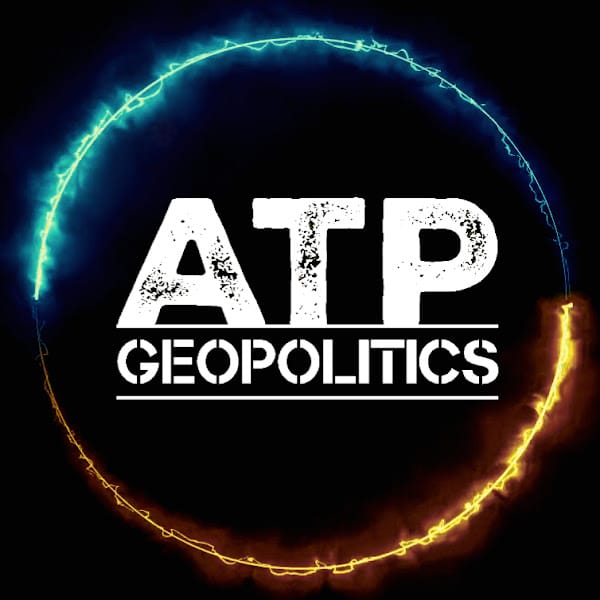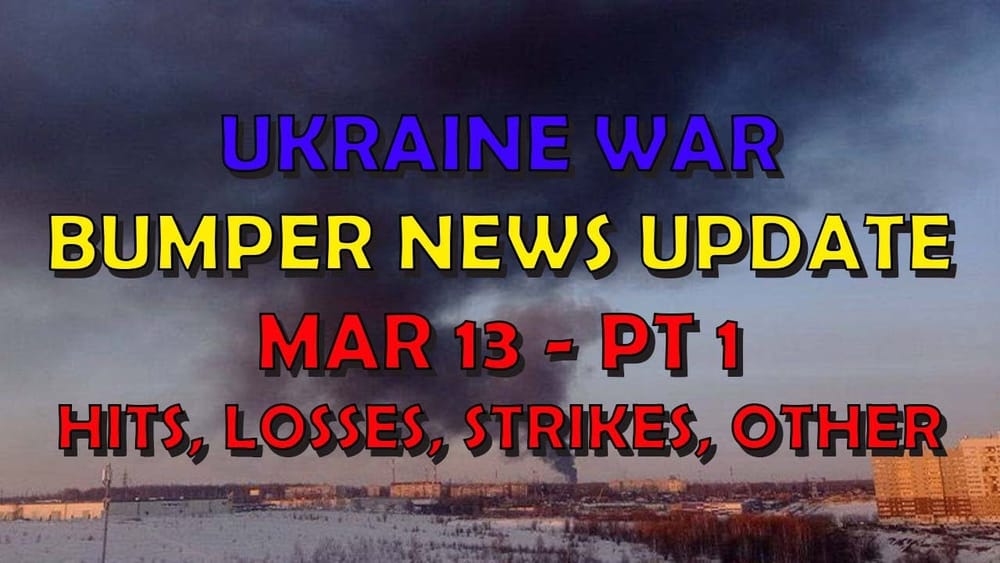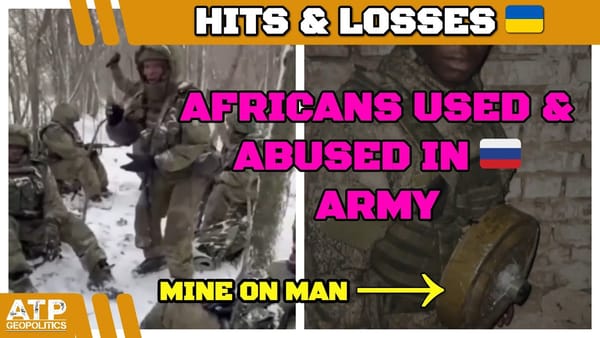Ukraine War Update BUMPER NEWS: Pt 1 - Overnight & Other News
Table of Contents 📖
"Russia's oil and gas pipeline and refinery industry is a sitting duck in a shooting gallery"
Hello Team
🎦 00:00-01:00⏩
Jonathan welcomes viewers to the channel, remarking on the vast amount of information to cover. He highlights the upcoming Russian presidential election as a potential driver for the recent surge in news, promising a potentially "mental" week ahead.
Return to top⤴️
🪦 DISCLAIMER FOR GENERAL STAFF LOSSES DATA
- These are real people with real lives and real families who love them. Don’t let the numbers sap your humanity.
- These numbers probably aren’t accurate but they’re the best we have and we don’t need them to be accurate to be indicative of patterns of activity.
- All losses are estimates. Losses cannot be counted with accuracy because of the conditions on the ground.
- Both sides would see it to be of their advantage to minimize their own losses maximize the other side’s losses.
- Neither side releases their losses but we have enough transparency from the Ukrainian side to have confidence in they are indicative.
- Personnel losses are hard to count. If a soldier gets injured, heals up, and returns to the front line only to get injured again, is that one loss or two? Also, how to deal with losses from PMC’s or soldiers fighting with RF from occupied territories?
- Equipment losses are hard to count. If an AA complex involves several parts and one part gets disabled, is that a loss, or a fraction of a loss? If a tank gets disabled, repaired, back into the fight, then disabled again, is that one lost tank or two?
- All recorded losses are vulnerable to multiple reporting. We have already seen numerous cases of multiple drones in the air reporting the same loss from different angles as multiple engagements.
- Losses are not always reported on the same day they occurred. It is frequent that drone losses are reported at least 24 hours after other terrestrial equipment losses. Certain losses may not be reported for days or weeks for military intelligence reasons.
Ukrainian General Staff Data - Russian Losses
🎦 01:00-02:32⏩
Jonathan reviews the latest Ukrainian General Staff figures for Russian losses, which include 980 personnel. This represents another significant loss for the Russians. Other notable losses include:
- 5 tanks
- 20 armoured personnel vehicles (APVs)
- 32 artillery systems
- 1 multiple launch rocket system (MLRS)
- 2 anti-aircraft warfare systems
- 62 vehicles and fuel tanks
- 8 pieces of special equipment
Jonathan emphasizes the consistent losses in artillery and APVs as being particularly impactful.
Return to top⤴️
Oryx - Visually Confirmed Losses
🎦 02:32-03:16⏩
Jonathan examines the latest visually confirmed loss data from Oryx, curated by Andrew Perpetua and his team. He notes that Oryx data broadly supports the Ukrainian General Staff figures. The data highlights that Russian equipment losses continue to outpace Ukrainian losses at a rate of three or four to one, which represents a positive trend for Ukraine.
Return to top⤴️
Oryx - Ukrainian Losses
🎦 03:16-05:09⏩
Moving to Ukrainian losses, Jonathan points to a potential high-mobility artillery rocket system (HIMARS) loss, but Andrew Perpetua (Oryx) believes it may be a decoy. Other losses include:
- Surveillance and comms equipment
- 2 boats
- 2 x M777 howitzers
- 1 x Stridsfarm 122 tank (Swedish Leopard 2A5 variant) - Jonathan notes that this is considered one of the best tanks available to Ukraine.
- 3 x BMP-1s
- 2 x M113 APCs
- Humvees
- A number of SUVs.
Jonathan considers these losses to be fairly average in terms of their overall value.
Return to top⤴️
Oryx - Detailed Russian Losses
🎦 05:09-07:06⏩
Jonathan analyses the details of the Oryx visually confirmed Russian losses. Notable losses include:
- 1 x IL-76 (lost northeast of Moscow, at Ivanovo)
- 2 x BUK-M1 air defence systems (taken out by a Gimler and FPV drone)
- Surveillance and comms equipment
- A BREM recovery vehicle
- A range of artillery pieces (including another 240 mm Tulip self-propelled mortar)
- A number of tanks
- A significant number of infantry fighting vehicles (including BMP-1s, BMP-2s, BMP-3s, and BTRs).
- APCs (many destroyed or abandoned)
- TLBs
- A few BTRs
- Trucks
- Civilian vehicles.
Jonathan draws attention to the significant number of BMP-1 losses, highlighting the volume of equipment destroyed or abandoned. He reiterates the high overall value of the equipment losses.
Return to top⤴️
IL-76 Loss - Potential Impact on A-50 Crew Training
🎦 07:06-08:18⏩
Jonathan explores further the implications of the Russian IL-76 loss. He cites Spartan News reports that two A-50 AWACS aircraft were shot down previously, with a combined crew of 30. He speculates on the possibility of the IL-76 being used to train new A-50 crews, due to the earlier losses, potentially representing a further blow to Russian air capability. Unconfirmed chatter on Telegram suggests that the IL-76 may have been carrying an A-50 crew on a recovery mission to replace the ones damaged the previous week, potentially as a result of a bird strike. However, Jonathan emphasizes that the Telegram source is unconfirmed.
Return to top⤴️
Pro-Ukrainian Russian Incursions into Belgorod and Kursk
🎦 08:18-09:18⏩
Shifting focus to the pro-Ukrainian Russian incursions into the Belgorod and Kursk regions, Jonathan shows footage of a damaged tank at a border crossing, where Russian forces claim to have repelled the incursion. He notes conflicting claims surrounding equipment losses and the status of the incursion, highlighting the ongoing information war.
Return to top⤴️
Russian S-400 Unit Attacked
🎦 09:19-11:27⏩
Jonathan presents footage of a Russian S-400 air defence unit engaging incoming projectiles, possibly HIMARS or Gimler rockets. The footage, taken from inside the early warning and acquisition radar system, shows S-400 missiles being fired. The source claims minimal damage to the S-400 TEL and light injuries to one operator. Jonathan questions the cost-effectiveness of using such a system against less expensive munitions and draws parallels to previous Russian efforts to deplete Ukrainian air defences through missile and drone attacks.
Return to top⤴️
Pro-Ukrainian Russian Incursions: FPV Drone Usage & Conflicting Claims
🎦 11:27-12:16⏩
Returning to the cross-border incursions, Jonathan shows footage from the Russian Volunteer Corps (RVC) demonstrating their use of FPV drones to target Russian vehicles and troop transports. Despite Russian claims of repelling the incursions, Jonathan notes footage of ongoing RVC activity, suggesting otherwise. He acknowledges the difficulty in determining the accuracy of the claims from both sides.
Return to top⤴️
Overnight Drone and Missile Attacks
🎦 12:16-16:57⏩
Jonathan delves into the overnight drone and missile attacks. Ukraine reports shooting down 17 out of 22 Shahed-type drones, with the remaining five impacting Khmelnytskyi, Dnipropetrovsk and Kherson. Jonathan suggests that these attacks might be in retaliation for the successful Ukrainian strikes on Russian oil infrastructure, alongside the downing of the IL-76. Key developments:
- Russians launch three S-300 missiles into Kharkiv, targeting old hangars near the city.
- Krivyi Rih comes under missile attack. A nine-story apartment building suffers a direct hit, resulting in multiple civilian casualties, including children. Jonathan expresses his anger at this act of Russian terrorism.
- A drone attack in Sumy destroys an apartment building, injuring eight and leaving others missing.
- Overnight attacks on high-rise buildings in Myrnohrad, Donetsk Oblast, are reported, resulting in casualties.
- A missile is fired at Odesa, with explosions reported near the port.
Jonathan highlights the severity of the attacks on Ukrainian cities, condemning the targeting of civilian infrastructure.
Return to top⤴️
Analysis of Ukrainian Strikes on Russian Oil Infrastructure
🎦 16:57-23:45⏩
Jonathan dissects the Ukrainian strikes on Russian oil infrastructure, focusing on their significance and long-term implications. He cites analysis from:
- ChrisO_Wiki: Emphasises the damage inflicted by these strikes, emphasizing Russia's dependence on sanctioned Western technology for its oil industry.
- Joe Bloggs (YouTube): Reaffirms the impact of Western sanctions, highlighting the loss of expertise following the withdrawal of companies like ExxonMobil, BP, and Shell.
- Neon Handrail (OSINT investigator): Provides details on the drone strike in Nizhny Novgorod.
Jonathan emphasizes that the strikes, while seemingly limited in scope, are causing significant disruption to Russia's oil production and refining capabilities. He argues that these attacks are having both economic and political ramifications for Putin. Key takeaways from the analysis:
- The attacks are exacerbating gasoline shortages within Russia, a major oil producer, leading to a ban on petrol exports for six months and price controls.
- Ukraine appears to be targeting specific, critical pieces of infrastructure within the refineries, maximizing damage and disruption.
- The absence of air defences at some facilities makes them easy targets.
- Sustained attacks could create a political crisis for Putin as gasoline prices become a domestic issue, impacting ordinary Russians and potentially fuelling dissent.
- Refineries are legitimate military targets, and their disruption impacts Russia's ability to fuel its war machine.
- Attacks on refining and storage facilities do not directly impact global oil prices, as long as crude oil exports remain unaffected.
- Damage to Russian refineries can take months to repair, and Western sanctions hinder their ability to source parts and expertise.
Jonathan believes Ukraine has only begun to exploit the vulnerability of Russia's sprawling energy infrastructure and predicts further attacks. He acknowledges that Russia will attempt countermeasures but questions their ability to adequately defend such a vast network.
Return to top⤴️
Overnight Drone Attacks on Russian Regions: An Overview
🎦 23:45-26:52⏩
Jonathan provides an overview of the latest drone attacks on Russian regions. The Russian Defence Ministry claims to have destroyed 65 Ukrainian drones overnight and into the morning, a claim contradicted by emerging footage. Key points:
- Initially, 11 drones were reported downed over Belgorod, eight over Bryansk, 29 over Voronezh, eight over Kursk, and one each over the Ryazan and Leningrad regions.
- A later report added seven more drones downed over Belgorod and Voronezh.
- The attacks targeted an airfield south of Buturlinovka (Voronezh) and infrastructure in Ryazan, Voronezh, Kursk, Belgorod, and Bryansk.
- A drone was also destroyed in the Kronshtadt district of the Leningrad region, near the Kirishy oil refinery.
- The Russian Defence Ministry later revised its drone downing figure to 58.
Jonathan points to the sheer scale of the drone attacks, suggesting that Ukraine is now producing attack drones at scale, enabling them to overwhelm Russian air defences. He predicts this will become a recurring challenge for Russia.
Return to top⤴️
Analysis: Ukrainian Drones Overwhelm Russian Defences
🎦 26:52-31:50⏩
Jonathan dissects footage of Ukrainian drones successfully striking targets inside Russia, emphasizing the apparent ease with which they are penetrating Russian airspace. He uses footage of a drone circling over an oil refinery in Ryazan before striking it, highlighting the lack of effective Russian air defence in that instance. He also showcases similar footage from the Voronezh region, emphasizing the widespread nature of these successful strikes. Jonathan notes:
- The drones used in the attacks appear to be long-range models, such as the Mugin-5 (later corrected to the Ukrainian-made Luti), capable of significant payloads.
- Russian air defences appear to be overwhelmed and outmatched by the number of drones and the tactics employed.
Jonathan believes:
- Ukrainian drone strikes on Russia's critical infrastructure are becoming increasingly frequent and damaging.
- The situation presents a strategic dilemma for Russia, forcing them to choose between defending their vast territory and maintaining air defence over the front lines in Ukraine.
- The success of these attacks can be attributed, in part, to the West's reluctance to provide Ukraine with weapons systems capable of striking deep inside Russia, forcing them to rely on their own domestic production capabilities.
The "Putin Paradox": Escalation and the Nuclear Threat
🎦 31:50-32:38⏩
Jonathan introduces the concept of the "Putin Paradox," arguing that the more successful Ukraine becomes on the battlefield, the more likely Putin is to resort to desperate and potentially reckless measures. He points to recent reports of Putin once again issuing veiled nuclear threats as evidence that the situation is having a significant impact on the Russian leader.
Return to top⤴️
Conflicting Narratives: Pro-Ukrainian Incursions into Russia
🎦 32:38-39:48⏩
Jonathan examines the conflicting narratives surrounding the pro-Ukrainian Russian incursions into Belgorod and Kursk. He contrasts:
- The Russian Ministry of Defence/Syrianmaps: They present the incursions as repelled, emphasizing heavy losses inflicted on the “invading force” and the "propaganda" nature of the operation.
- The Freedom of Russia Legion/RVC/Tim White: They claim to have liberated part of the village of Tetkino (Kursk region), maintaining a presence in the area and reporting ongoing fighting.
Jonathan uses maps to analyse the strategic significance of Tetkino. He explains how its geographic location, partially surrounded by Ukrainian territory and bordered by a river, makes it a difficult position for Russian forces to retake. He highlights the advantages provided by Ukrainian artillery positioned across the border, questioning the long-term viability of Russia retaking and holding the area. Jonathan acknowledges that, while the situation remains fluid, the pro-Ukrainian forces have chosen their location strategically, potentially indicating an attempt to draw Russian resources away from other areas.
Return to top⤴️
Zelensky: Russia's Offensive Stalled
🎦 39:48-41:23⏩
Jonathan reports on a claim, attributed to Zelensky by Max23, that Russia's offensive in the east has been halted. He expresses caution about the claim, suggesting it could be overly optimistic, but concedes that recent Russian setbacks and Putin's renewed nuclear sabre-rattling could point to serious problems for the Russian military. He acknowledges that while some limited Russian gains might be possible, they are unlikely to be strategically significant.
Return to top⤴️
Putin Renews Nuclear Threats
🎦 41:23-41:51⏩
Jonathan discusses Putin's recent nuclear threats, suggesting that they are a sign of Russia's struggles both in Ukraine and domestically. He argues that these threats, while not to be taken lightly, are primarily a form of sabre-rattling intended to intimidate and deter further Ukrainian action.
Return to top⤴️
Leonid Volkov (Navalny Ally) Attacked in Lithuania
🎦 41:51-42:32⏩
Jonathan reports on the attack on Leonid Volkov, a close associate of imprisoned Russian opposition leader Alexei Navalny. Volkov, who was living in exile in Lithuania, was assaulted near his home, allegedly by an individual wielding a hammer. The attacker reportedly smashed Volkov's car window and sprayed him with tear gas. Jonathan expresses his concern for Volkov's well-being and notes that the attack is widely viewed as politically motivated.
Return to top⤴️
Twitter/X: Ongoing Bias Against Pro-Ukrainian Voices
🎦 42:32-45:57⏩
Jonathan criticizes Twitter/X and its owner, Elon Musk, for continuing to suppress pro-Ukrainian voices and perspectives on the platform. He highlights:
- Numerous pro-Ukrainian accounts, including those associated with the North Atlantic Fellas Organization (NAFO), are being falsely flagged as spam or engaging in platform manipulation.
- Previous leaks of Twitter's code revealed that pro-Ukrainian content is deliberately downranked and disadvantaged by the platform's algorithm.
- Similar algorithmic manipulation is used to amplify Elon Musk's own tweets and those of his associates, many of whom have promoted pro-Russian narratives and disinformation about the war.
- Community Notes, a feature intended to combat misinformation, are often suppressed or deleted when they challenge false claims made by Musk and his allies.
Jonathan concludes by accusing Musk of hypocrisy for claiming to be a "free speech absolutist" while actively censoring and suppressing dissenting voices, particularly those critical of Russia's actions in Ukraine.
Return to top⤴️
Wrap Up
🎦 45:57-46:04⏩
Jonathan signs off, thanking viewers for watching and encouraging them to like, subscribe, and share the video.
Return to top⤴️




